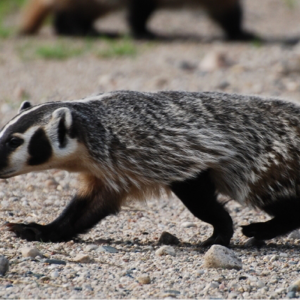L’ours grizzli
Vital Signs
Common name: Grizzly Bear
Latin name: Ursus Arctos
Status under SARA: Currently no status under SARA. The 2012 COSEWIC Assessment designated the species under Special Concern.
Range: The Grizzly Bear can be found in all three Canadian territories, in addition to British Columbia, Alberta, northern Saskatchewan, northeast Manitoba and as well as a few places in the southwest Canadian Arctic Archipelago. Summed together, the total range has been estimated to cover approximately 2.98 million km².
Life Span: In nature, Grizzly Bears have an expected lifespan of around 20-30 years.
Size: Adult females have masses between 100-150 kg, and fully grown males range between 180-270 kg.
Population estimate: The Canadian population of Grizzly Bears is estimated to be around 26,000, but the number of mature Grizzlies could be closer to 10,000.
The Facts
- Grizzly Bears are able to adapt to a wide variety of habitats. A few examples of habitable ecosystems include temperate coastal rain forests, alpine tundra and prairie grasslands.
- Grizzly Bears are well-adapted for digging, hunting, grazing and rooting, and these bears are omnivorous.
- Grizzly Bears live in dens during the winter and can hibernate up to 7 months.
- Female Grizzlies begin mating at the age of 6 years and their litters are comprised of 1-3 cubs. The bear cubs are born in the winter dens in January or February.
The Story
In Canada, though historical records are lacking, the population of Grizzlies is suspected to have declined dramatically as a result of European settlement. As a case in point, the species has been completely extirpated from its former ranges in the interior of southern British Columbia, the prairies of Alberta, Saskatchewan and Manitoba, and the Ungava region of Labrador and northern Quebec. While the range of the species has expanded in some areas, and the total population has appeared to have stabilized since the 1990s, there is evidence of further population declines in southern BC, the Yukon and Alberta. Population fragmentation has also put entire local populations at risk.
Anthropogenic activities have had a large effect on the Grizzly Bear population. Direct human-incurred deaths are caused by legal hunting, poaching, defense of life and property, and collisions with trains or motor-vehicles. Humans also have greatly limited habitable range available to the bears, causing great habitat losses. In addition to causing higher mortality rates near roads and residential areas, human settlement has been believed to fragment and isolate existing Grizzly Bear populations. It’s believed to affect reproduction and survival in a manner which greatly increases the isolated population’s chances of local extinction.
What’s Being Done
One of the major ways in which Grizzly Bears are currently protected is through hunting regulations. While Manitoba, Quebec, Saskatchewan and Newfoundland and Labrador do not give Grizzly Bears any special legal status, the territories, British-Columbia and Alberta all have some hunting restrictions in place. In Alberta, it is no longer legal to hunt Grizzly Bears (with the exception of Aboriginal subsistence hunting). Westwards, in British Columbia, hunting is limited by the number of hunting authorizations which are issued to resident hunters through a random draw. The province also has severe penalties for the possession, selling or exporting of trophy body parts. In the Yukon, a quota system is in place which strongly incentivizes hunting male bears instead of females, as well as staying within the given quota for female bears. To the east, in the Northwest Territories, cubs, bears accompanying cubs (usually their mothers) and bears in dens are protected. Unfortunately, Nunavut has little restrictions in place for the hunting of Grizzlies.
Conservation of Grizzly Bears is also available through protected areas such as parks or reserves. It is currently estimated that around 7.1% of the total range of Grizzly Bears is protected to some degree, through hunting regulations and/or restrictions on human activities.
What You Can Do
Ask your local provincial or territorial MP to support stiff Grizzly Bear hunting restrictions in your area.
Purchase Bear-resistant trash and electric fences if you live near or in rural areas. This will help to prevent Grizzly Bears from coming onto your property and getting into your garbages.
Educate yourself on bear safety. Learn about what you should do if you ever encounter a bear in the wild.
Resources
Species at Risk Act Registry, SARA.
COSEWIC Assessment and Status Report on the Grizzly Bear.
Thanks to Nature Canada volunteer Claire Smith for contributing this profile.


